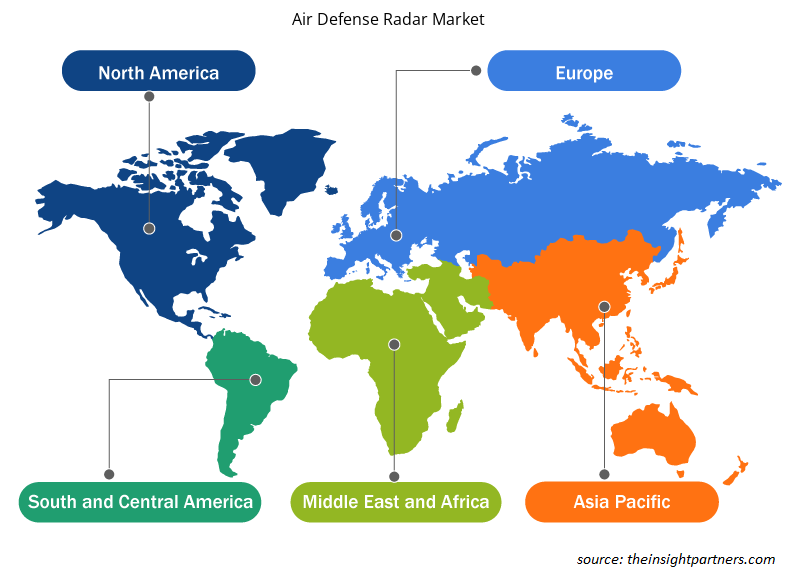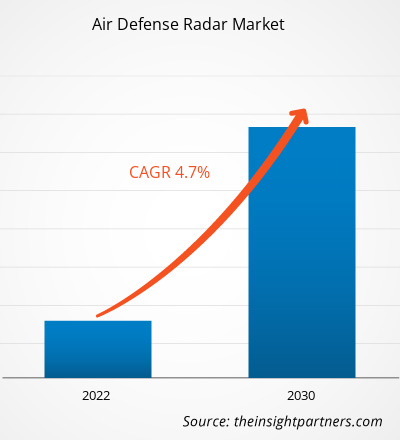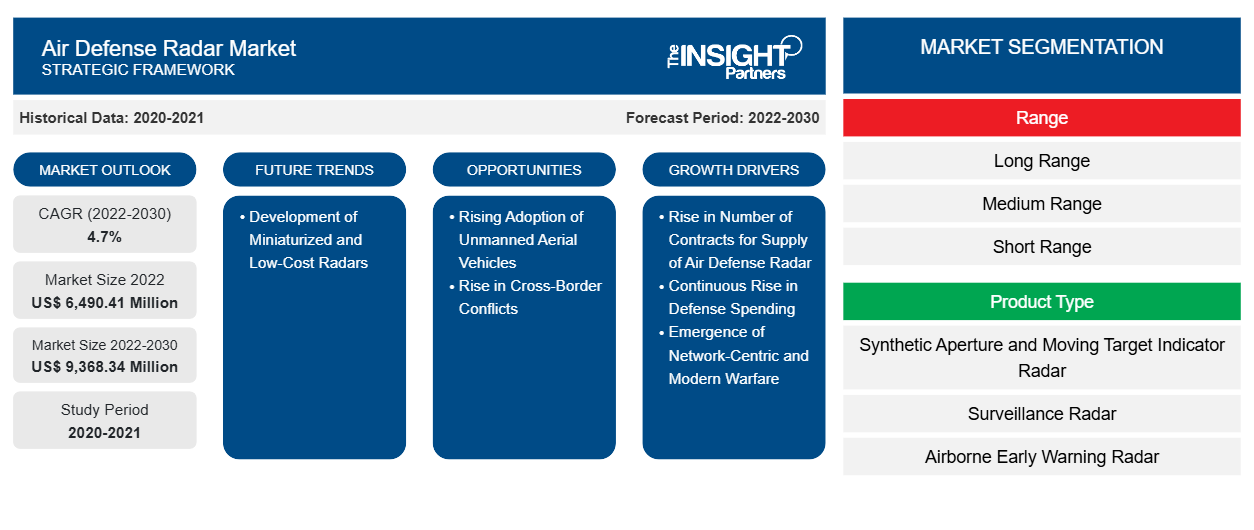Der Markt für Luftverteidigungsradare soll von 6.490,41 Millionen US-Dollar im Jahr 2022 auf 9.368,34 Millionen US-Dollar im Jahr 2030 anwachsen. Der Markt soll im Zeitraum 2022–2030 eine durchschnittliche jährliche Wachstumsrate (CAGR) von 4,7 % verzeichnen. Die Entwicklung miniaturisierter und kostengünstiger Radare dürfte ein wichtiger Trend auf dem Markt für Luftverteidigungsradare bleiben.
Marktanalyse für Luftverteidigungsradare
Stör- und Täuschungstechniken können die Lagewahrnehmung durch Radarsysteme der Luftverteidigung beeinträchtigen. Durch Störungen von Radarsignalen oder die Bereitstellung falscher Informationen können diese Techniken Bediener und Entscheidungsträger in die Irre führen und zu ungenauen Einschätzungen der Bedrohung führen. Eine verringerte Lagewahrnehmung behindert die Fähigkeit, effektiv auf Bedrohungen aus der Luft zu reagieren, und kann den Gesamterfolg der Mission gefährden. Hersteller und Betreiber von Radarsystemen entwickeln kontinuierlich Gegenmaßnahmen, um die Auswirkungen von Stör- und Täuschungstechniken abzumildern. Diese Gegenmaßnahmen können fortschrittliche Signalverarbeitungsalgorithmen, adaptive Wellenformgenerierung oder die Integration ergänzender Sensorsysteme umfassen. Mit der Weiterentwicklung der Gegenmaßnahmen können Gegner jedoch ausgefeiltere Stör- und Täuschungstechniken entwickeln, was laufende Investitionen in Forschung und Entwicklung erforderlich macht. Um die Auswirkungen von Stör- und Täuschungstechniken abzumildern, ist häufig die Integration zusätzlicher Technologien und Systeme in die Radararchitektur erforderlich. Dies kann die Kosten und Komplexität von Radarsystemen der Luftverteidigung erhöhen und ihre Beschaffung und Wartung schwieriger machen. Unternehmen müssen in robuste Gegenmaßnahmen, Schulungen und regelmäßige Updates investieren, um den sich entwickelnden Stör- und Spoofing-Techniken immer einen Schritt voraus zu sein.
Marktübersicht für Luftverteidigungsradare
Die Endnutzer von Luftverteidigungsradaren können je nach spezifischer Anwendung und der für Verteidigung und Sicherheit verantwortlichen Organisation variieren. Sie können von Streitkräften wie nationalen Armeen, Luftwaffen und Seestreitkräften sowie Grenzschutzbehörden eingesetzt werden . Sie können auch in militärischen Flugsicherungssystemen verwendet werden. Darüber hinaus spielen Luftverteidigungsradare eine entscheidende Rolle in den Luftverteidigungssystemen der NATO (North Atlantic Treaty Organization) und der alliierten Streitkräfte. Diese Radare gewährleisten auch die Verteidigung und Sicherheit der EU-Mitgliedsländer, bieten Lagebewusstsein und tragen zu gemeinsamen Verteidigungsoperationen bei. Außerdem können einige Endnutzer von Luftverteidigungsradaren je nach geopolitischem Kontext und den spezifischen Anforderungen jedes Landes oder jeder Organisation variieren.
Passen Sie diesen Bericht Ihren Anforderungen an
Sie erhalten kostenlos individuelle Anpassungen an jedem Bericht, einschließlich Teilen dieses Berichts oder einer Analyse auf Länderebene, eines Excel-Datenpakets sowie tolle Angebote und Rabatte für Start-ups und Universitäten.
-
Holen Sie sich die wichtigsten Markttrends aus diesem Bericht.Dieses KOSTENLOSE Beispiel umfasst eine Datenanalyse von Markttrends bis hin zu Schätzungen und Prognosen.
Treiber und Chancen auf dem Luftverteidigungsradarmarkt
Entstehung netzwerkzentrierter und moderner Kriegsführung
Die netzwerkzentrierte Kriegsführung beruht auf dem schnellen Austausch, der schnellen Fusion und der schnellen Analyse von Daten aus verschiedenen Quellen. Radarsysteme zur Luftabwehr generieren wichtige Daten für die Fusion und Korrelation, indem sie Eingaben von anderen Sensoren und Geheimdienstquellen verwenden. Dies erleichtert die Entwicklung eines umfassenden und genauen Luftbildes und ermöglicht präzisere Bedrohungseinschätzungen und Zielbekämpfungen. Daher legen netzwerkzentrierte Kriegsführung und moderne Kriegsführungskonzepte Wert auf verbessertes Lagebewusstsein, integrierte Verteidigungssysteme, schnellen Datenaustausch, verbesserte Zielbekämpfung, elektronische Kriegsführungsfähigkeiten und Anpassungsfähigkeit an sich entwickelnde Bedrohungen. Daher treibt die zunehmende Einführung netzwerkzentrierter und moderner Kriegsführung die Entwicklung fortschrittlicher Radartechnologien weiter voran, um eine effektive Luftverteidigung in modernen Einsatzumgebungen zu unterstützen.
Zunahme grenzüberschreitender Konflikte – eine Chance für den Markt für Luftverteidigungsradare
Die ständigen Spannungen zwischen Ländern wie Indien und Pakistan, China und Taiwan, China und Indien, Russland und der Ukraine sowie Israel und Palästina zwingen die jeweiligen Regierungen, ihre Streitkräfte zu stärken. Daher konzentrieren sich die Streitkräfte dieser Länder auf die Beschaffung von Luftabwehrsystemen. Grenzüberschreitende Konflikte sind häufig mit Bedrohungen durch Luftplattformen wie Flugzeuge, unbemannte Luftfahrzeuge und Raketen verbunden. Luftabwehrradarsysteme spielen eine wichtige Rolle bei der Grenzüberwachung, indem sie diese Bedrohungen erkennen und verfolgen, frühzeitig warnen und schnelle Reaktionsmöglichkeiten, einschließlich Evakuierungsmaßnahmen, ermöglichen. Grenzüberschreitende Konflikte können auch zur Zerstörung kritischer Infrastrukturen wie Flughäfen, Kraftwerken und verschiedenen staatlichen Einrichtungen führen. Die Notwendigkeit einer verstärkten Überwachung zum Schutz der Grenzen und anderer kritischer Infrastrukturen treibt die Nachfrage nach fortschrittlichen Radarsystemen, einschließlich Luftabwehrradarsystemen, in Konfliktgebieten voran. Darüber hinaus errichten Streitkräfte häufig vorgeschobene Operationsbasen (FOBs) in der Nähe von Konfliktgebieten. Diese FOBs erfordern robuste Luftabwehrfähigkeiten zum Schutz von Personal und Ausrüstung. Luftabwehrradarsysteme sind ein wesentlicher Bestandteil von FOBs und bieten Überwachungs-, Erkennungs- und Reaktionsmöglichkeiten gegen Bedrohungen aus der Luft. Daher ist zu erwarten, dass der zunehmende Einsatz von Luftabwehrradaren in Konfliktgebieten in den kommenden Jahren Chancen für das Wachstum des Marktes für Luftabwehrradare schaffen wird.
Segmentierungsanalyse des Marktberichts für Luftverteidigungsradare
Wichtige Segmente, die zur Ableitung der Marktanalyse für Luftverteidigungsradare beigetragen haben , sind Reichweite, Produkttyp, Systemtyp, Plattform und Anwendung.
- Basierend auf der Reichweite ist der Markt für Luftverteidigungsradare in Langstrecken-, Mittelstrecken- und Kurzstrecken unterteilt. Das Langstreckensegment hatte im Jahr 2022 einen größeren Marktanteil.
- Basierend auf dem Produkttyp ist der Markt für Luftverteidigungsradare in Radare mit synthetischer Apertur und Radare mit beweglicher Zielanzeige, Überwachungsradar, luftgestütztes Frühwarnradar, Multifunktionsradar, Wetterradar und andere unterteilt . Das Segment der Radare mit synthetischer Apertur und Radare mit beweglicher Zielanzeige hatte im Jahr 2022 einen größeren Marktanteil.
- Basierend auf dem Systemtyp ist der Markt für Luftverteidigungsradare in fest installierte und tragbare Radargeräte unterteilt. Das Segment der fest installierten Radargeräte hatte im Jahr 2022 einen größeren Marktanteil.
- Basierend auf der Plattform ist der Markt für Luftverteidigungsradare in bodengestützte, flugzeuggestützte und marinegestützte Radare unterteilt. Das bodengestützte Segment hielt im Jahr 2022 einen größeren Marktanteil.
- Basierend auf der Anwendung ist der Markt für Luftverteidigungsradare in ballistische Raketenabwehr, Freund-Feind-Erkennung, Wettervorhersage und andere unterteilt. Das Segment Freund-Feind-Erkennung hatte im Jahr 2022 einen größeren Marktanteil.
Marktanteilsanalyse für Luftverteidigungsradare nach geografischer Lage
Der geografische Umfang des Marktberichts zum Luftverteidigungsradar ist hauptsächlich in fünf Regionen unterteilt: Nordamerika, Asien-Pazifik, Europa, Naher Osten und Afrika sowie Südamerika.
Im Jahr 2023 hatte Nordamerika einen großen Anteil am globalen Markt für Luftverteidigungsradare, gefolgt von Europa und dem asiatisch-pazifischen Raum. Der Markt für Luftverteidigungsradare in Nordamerika wird hauptsächlich von wichtigen Akteuren wie General Dynamics Corporation, Honeywell International Inc, Lockheed Martin Corporation, Northrop Grumman Corporation und Raytheon Technologies Corporation angetrieben. Darüber hinaus erhöhen die geopolitischen Spannungen in der Region die Militärausgaben. Laut Stockholm International Peace Research Institute (SIPRI) beliefen sich die Militärausgaben Nordamerikas im Jahr 2020 auf 809.723,4 Millionen US-Dollar; sie stiegen im Jahr 2021 auf 840.273,3 Millionen US-Dollar und erreichten im Jahr 2022 912.375,03 Millionen US-Dollar. Somit stimuliert der wachsende Militärhaushalt die Beschaffung verschiedener Verteidigungssysteme. Laut dem World Directory of Modern Military Aircraft (WDMMA) und dem Global Fire Power Index (FPI) verfügt Nordamerika derzeit über 466 Flotten, darunter Fregatten, Korvetten, Zerstörer, Flugzeugträger und U-Boote. Abgesehen davon sicherte sich die Region im Jahr 2023 72 Flotten für zukünftige Beschaffungen. Da Radarsysteme eine wesentliche Rolle bei der Zielidentifizierung und den Verfolgungsfähigkeiten von Verteidigungssystemen spielen, wird erwartet, dass die steigende Beschaffung von Verteidigungssystemen die Nachfrage nach Radarsystemen zur Luftverteidigung im Prognosezeitraum ankurbeln wird.
Regionale Einblicke in den Markt für Luftverteidigungsradar
Die regionalen Trends und Faktoren, die den Markt für Luftverteidigungsradare im Prognosezeitraum beeinflussen, wurden von den Analysten von Insight Partners ausführlich erläutert. In diesem Abschnitt werden auch Marktsegmente und Geografien für Luftverteidigungsradare in Nordamerika, Europa, im asiatisch-pazifischen Raum, im Nahen Osten und Afrika sowie in Süd- und Mittelamerika erörtert.

- Erhalten Sie regionale Daten zum Markt für Luftverteidigungsradare
Umfang des Marktberichts zum Luftverteidigungsradar
| Berichtsattribut | Details |
|---|---|
| Marktgröße im Jahr 2022 | 6.490,41 Millionen US-Dollar |
| Marktgröße bis 2030 | 9.368,34 Millionen US-Dollar |
| Globale CAGR (2022-2030) | 4,7 % |
| Historische Daten | 2020-2021 |
| Prognosezeitraum | 2022–2030 |
| Abgedeckte Segmente |
Nach Sortiment
|
| Abgedeckte Regionen und Länder |
Nordamerika
|
| Marktführer und wichtige Unternehmensprofile |
|
Marktteilnehmerdichte: Der Einfluss auf die Geschäftsdynamik
Der Markt für Luftverteidigungsradare wächst rasant, angetrieben durch die steigende Endverbrauchernachfrage aufgrund von Faktoren wie sich entwickelnden Verbraucherpräferenzen, technologischen Fortschritten und einem größeren Bewusstsein für die Vorteile des Produkts. Mit steigender Nachfrage erweitern Unternehmen ihr Angebot, entwickeln Innovationen, um die Bedürfnisse der Verbraucher zu erfüllen, und nutzen neue Trends, was das Marktwachstum weiter ankurbelt.
Die Marktteilnehmerdichte bezieht sich auf die Verteilung von Firmen oder Unternehmen, die in einem bestimmten Markt oder einer bestimmten Branche tätig sind. Sie gibt an, wie viele Wettbewerber (Marktteilnehmer) in einem bestimmten Marktraum im Verhältnis zu seiner Größe oder seinem gesamten Marktwert präsent sind.
Die wichtigsten auf dem Markt für Luftverteidigungsradare tätigen Unternehmen sind:
- BAE Systems Plc
- General Dynamics Corp
- Honeywell International Inc
- Israel Aerospace Industries Ltd
- Leonardo SpA
- Lockheed Martin Corporation
Haftungsausschluss : Die oben aufgeführten Unternehmen sind nicht in einer bestimmten Reihenfolge aufgeführt.

- Überblick über die wichtigsten Akteure auf dem Markt für Luftverteidigungsradar
Nachrichten und aktuelle Entwicklungen zum Luftverteidigungsradarmarkt
Der Markt für Luftverteidigungsradare wird durch die Erhebung qualitativer und quantitativer Daten nach Primär- und Sekundärforschung bewertet, die wichtige Unternehmensveröffentlichungen, Verbandsdaten und Datenbanken umfasst. Im Folgenden finden Sie eine Liste der Entwicklungen auf dem Markt für Innovationen, Geschäftserweiterungen und Strategien:
- Im Jahr 2023 gab Honeywell bekannt, dass die Küstenwache der Vereinigten Staaten (USCG) sich für das Wetterradarsystem IntuVue RDR-7000 von Honeywell als Upgrade für die bestehenden Systeme ihrer Mehrzweckhubschrauber Sikorsky MH-60 Jayhawk und Eurocopter MH-65 Dolphin entschieden hat. Das Upgrade des RDR-7000 baut auf der starken Leistung und Situationswahrnehmung des derzeit installierten Wetterradarsystems Honeywell P701 auf. (Quelle: Honeywell International Inc, Pressemitteilung)
- Im Jahr 2023 entschied sich die norwegische Luftwaffe für das bodengestützte Luftüberwachungsradar TPY-4 der nächsten Generation von Lockheed Martin, um die Fernüberwachungsfähigkeit des Landes zu verbessern. Die norwegischen TPY-4-Radare werden in die aktive Produktionslinie von Lockheed Martin integriert, was dies für die norwegische Verteidigungsmaterialagentur zu einer risikoarmen Option macht. (Quelle: Lockheed Martin Corporation, Newsletter)
Marktbericht zum Luftverteidigungsradar – Abdeckung und Ergebnisse
Der Bericht „Marktgröße und Prognose für Luftverteidigungsradar (2020–2030)“ bietet eine detaillierte Analyse des Marktes, die die folgenden Bereiche abdeckt:
- Marktgröße und Prognose für Luftverteidigungsradar auf globaler, regionaler und Länderebene für alle wichtigen Marktsegmente, die im Rahmen des Berichts abgedeckt sind
- Marktdynamik wie Treiber, Beschränkungen und wichtige Chancen
- Markttrends für Luftverteidigungsradar
- Detaillierte Porters Fünf Kräfte
- Marktanalyse für Luftverteidigungsradare mit wichtigen Markttrends, globalen und regionalen Rahmenbedingungen, wichtigen Akteuren, Vorschriften und jüngsten Marktentwicklungen
- Branchenlandschaft und Wettbewerbsanalyse für Luftverteidigungsradare, einschließlich Marktkonzentration, Heatmap-Analyse, prominenten Akteuren und aktuellen Entwicklungen
- Detaillierte Firmenprofile
- Historische Analyse (2 Jahre), Basisjahr, Prognose (7 Jahre) mit CAGR
- PEST- und SWOT-Analyse
- Marktgröße Wert/Volumen – Global, Regional, Land
- Branchen- und Wettbewerbslandschaft
- Excel-Datensatz
Aktuelle Berichte
Verwandte Berichte
Erfahrungsberichte
Grund zum Kauf
- Fundierte Entscheidungsfindung
- Marktdynamik verstehen
- Wettbewerbsanalyse
- Kundeneinblicke
- Marktprognosen
- Risikominimierung
- Strategische Planung
- Investitionsbegründung
- Identifizierung neuer Märkte
- Verbesserung von Marketingstrategien
- Steigerung der Betriebseffizienz
- Anpassung an regulatorische Trends























 Kostenlose Probe anfordern für - Markt für Luftverteidigungsradare
Kostenlose Probe anfordern für - Markt für Luftverteidigungsradare